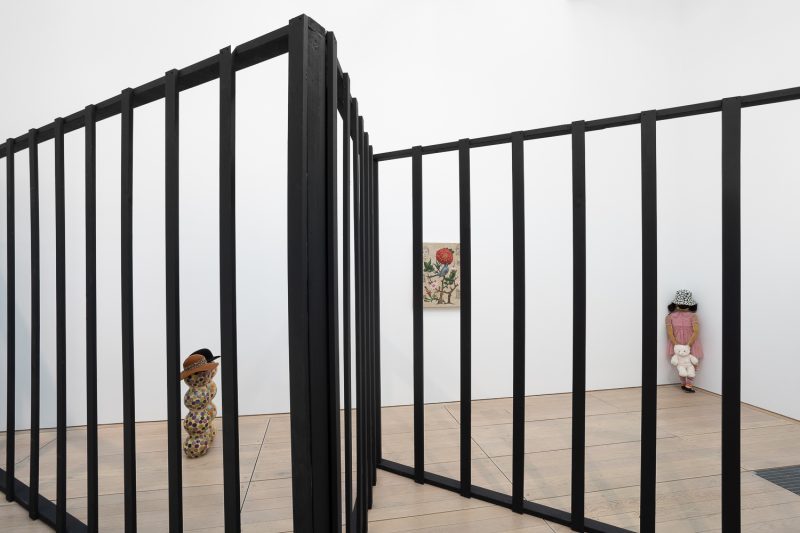HADI FALLAHPISHEH
As Free As Birds
This show at the CCA was Hadi Fallahpisheh’s first institutional solo exhibition in Europe. Working across painting, photography, ceramics, sculpture, performance and installation, Fallahpisheh wove a narrative that was part-allegory, part-fable. A recurring cast of a human, a mouse, a cat and a dog formed a quasi-family unit that at times felt nostalgic and domestic, but often veered toward entrapment and violence, prompting questions around belonging, conflict and anxiety.
Taking place across all four of the CCA’s upper galleries, the exhibition centred on ideas around freedom – its symbolisms, protections and contingencies. Life-size cages interrupted the exhibition experience, separating artwork from viewer. The exhibition’s title references the German concept of Vogelfrei, literally meaning “as free as a bird”, but which has been corrupted over time to mean “rightless, without protection, outlawed”, as defined by Italian philosopher Giorgio Agamben. Through literally caging both the viewer and his artworks, Fallahpisheh suggests that freedom is always a contradictory position that relies on the captive or unprotected status of others.
Fallahpisheh also presented the darkroom as prison, referencing the long periods of blacked-out isolation that his photographic paintings require. Drawing across photosensitive paper with colour gels and a torch, the artist leaves a large amount of his work to chance and improvisation, not knowing what colours might emerge until the end. Photography without a camera becomes a performance, emphasising the complete reliance on light in darkness to produce images. In this way, Fallahpisheh’s process references how past traumas are brought to light through therapy and exposure. His anthropomorphic characters – who often appear trapped in houses – present a kind of post-Disney family, their deliberately naïve style reflecting a childlike reliance on power structures and hierarchies. Transgressive and irrational, these figures raise questions around the framework of the family, and its in-built notions of harmony and containment.
Fallahpisheh plays with the innate power of certain objects to induce memories of childhood. A number of antique quilts from the 1920s served as backdrops or frames to the photographic paintings. They brought warmth and a sense of domesticity to the works, conjuring the sense of a body but also quaint interior décor and family heirlooms. The exhibition also featured ceramic works that veered between human-like forms and precariously stacked totems. The ceramics’ hard fragility sharply contrasted with their pliable appearance, with pots bent, balanced, wedged between each other and stuffed with soft toys. Stuffed animals – often in various states of distress – and fashion accessories served as nods to pop culture and the intimacy of nostalgia, and query how nostalgia can warp the boundaries between memory and imagination.
A new, choreographed performance entitled House Animals took place within the exhibition during the opening. Fallahpisheh’s cat, mouse and dog characters were embodied by dancers, with gentle reference to Merce Cunningham.
We are very grateful to the Hadi Fallahpisheh Exhibition Circle for their generous support towards the show: Andrew Kreps Gallery, New York, Efremidis, Berlin, and Rodeo, London/Piraeus.
Read more…
BIOGRAPHY
Hadi Fallahpisheh (b. 1987, Tehran) lives and works in New York. Fallahpisheh received his MFA in Photography from Bard College, Annandale-on-Hudson, New York in 2016. Fallahpisheh’s work was recently included in the 2022 Invitational Exhibition of Visual Arts at the American Academy of Arts and Letters, New York, Greater New York 2021, MoMA PS1, New York, 100 Drawings from Now at The Drawing Center, New York, 2020, In Practice: Total Disbelief, SculptureCenter, Long Island City, 2020, and Open Call, The Shed, New York, 2019. Recent solo exhibitions include The Power Station, Dallas, 2022, Champ Lacombe, Biarritz, 2022, Rodeo, London and Piraeus, 2021.
“The overriding desire of most children is to get at and see the soul of their toys … It is on the more or less swift invasion of this desire that depends the length of life of a toy. I do not find it in me to blame this infantile mania; it is a first metaphysical tendency. When this desire has implanted itself in the child’s cerebral marrow, it fills his fingers and nails with an extraordinary agility and strength. The child twists and turns his toy, scratches it, shakes it, bumps it against the walls, throws it on the ground. From time to time he makes it restart its mechanical motions, sometimes in the opposite direction. Its marvellous life comes to a stop. The child … makes a supreme effort; at last he opens it up, he is the stronger. But where is the soul? This is the beginning of melancholy and gloom.”
– Charles Baudelaire, ‘A Philosophy of Toys’
Read Less...








